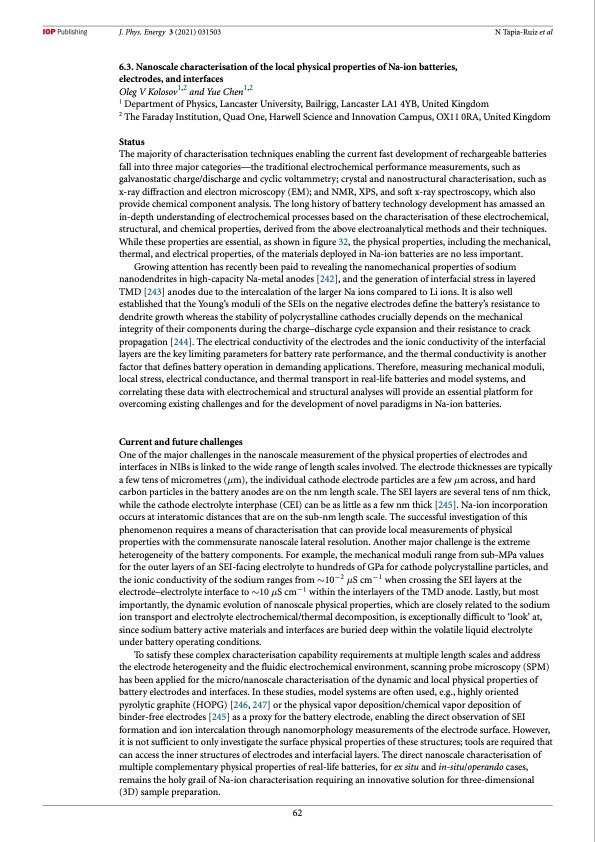
PDF Publication Title:
Text from PDF Page: 063
J. Phys. Energy 3 (2021) 031503 N Tapia-Ruiz et al 6.3. Nanoscale characterisation of the local physical properties of Na-ion batteries, electrodes, and interfaces Oleg V Kolosov1,2 and Yue Chen1,2 1 Department of Physics, Lancaster University, Bailrigg, Lancaster LA1 4YB, United Kingdom 2 The Faraday Institution, Quad One, Harwell Science and Innovation Campus, OX11 0RA, United Kingdom Status The majority of characterisation techniques enabling the current fast development of rechargeable batteries fall into three major categories—the traditional electrochemical performance measurements, such as galvanostatic charge/discharge and cyclic voltammetry; crystal and nanostructural characterisation, such as x-ray diffraction and electron microscopy (EM); and NMR, XPS, and soft x-ray spectroscopy, which also provide chemical component analysis. The long history of battery technology development has amassed an in-depth understanding of electrochemical processes based on the characterisation of these electrochemical, structural, and chemical properties, derived from the above electroanalytical methods and their techniques. While these properties are essential, as shown in figure 32, the physical properties, including the mechanical, thermal, and electrical properties, of the materials deployed in Na-ion batteries are no less important. Growing attention has recently been paid to revealing the nanomechanical properties of sodium nanodendrites in high-capacity Na-metal anodes [242], and the generation of interfacial stress in layered TMD [243] anodes due to the intercalation of the larger Na ions compared to Li ions. It is also well established that the Young’s moduli of the SEIs on the negative electrodes define the battery’s resistance to dendrite growth whereas the stability of polycrystalline cathodes crucially depends on the mechanical integrity of their components during the charge–discharge cycle expansion and their resistance to crack propagation [244]. The electrical conductivity of the electrodes and the ionic conductivity of the interfacial layers are the key limiting parameters for battery rate performance, and the thermal conductivity is another factor that defines battery operation in demanding applications. Therefore, measuring mechanical moduli, local stress, electrical conductance, and thermal transport in real-life batteries and model systems, and correlating these data with electrochemical and structural analyses will provide an essential platform for overcoming existing challenges and for the development of novel paradigms in Na-ion batteries. Current and future challenges One of the major challenges in the nanoscale measurement of the physical properties of electrodes and interfaces in NIBs is linked to the wide range of length scales involved. The electrode thicknesses are typically a few tens of micrometres (μm), the individual cathode electrode particles are a few μm across, and hard carbon particles in the battery anodes are on the nm length scale. The SEI layers are several tens of nm thick, while the cathode electrolyte interphase (CEI) can be as little as a few nm thick [245]. Na-ion incorporation occurs at interatomic distances that are on the sub-nm length scale. The successful investigation of this phenomenon requires a means of characterisation that can provide local measurements of physical properties with the commensurate nanoscale lateral resolution. Another major challenge is the extreme heterogeneity of the battery components. For example, the mechanical moduli range from sub-MPa values for the outer layers of an SEI-facing electrolyte to hundreds of GPa for cathode polycrystalline particles, and the ionic conductivity of the sodium ranges from ∼10−2 μS cm−1 when crossing the SEI layers at the electrode–electrolyte interface to ∼10 μS cm−1 within the interlayers of the TMD anode. Lastly, but most importantly, the dynamic evolution of nanoscale physical properties, which are closely related to the sodium ion transport and electrolyte electrochemical/thermal decomposition, is exceptionally difficult to ‘look’ at, since sodium battery active materials and interfaces are buried deep within the volatile liquid electrolyte under battery operating conditions. To satisfy these complex characterisation capability requirements at multiple length scales and address the electrode heterogeneity and the fluidic electrochemical environment, scanning probe microscopy (SPM) has been applied for the micro/nanoscale characterisation of the dynamic and local physical properties of battery electrodes and interfaces. In these studies, model systems are often used, e.g., highly oriented pyrolytic graphite (HOPG) [246, 247] or the physical vapor deposition/chemical vapor deposition of binder-free electrodes [245] as a proxy for the battery electrode, enabling the direct observation of SEI formation and ion intercalation through nanomorphology measurements of the electrode surface. However, it is not sufficient to only investigate the surface physical properties of these structures; tools are required that can access the inner structures of electrodes and interfacial layers. The direct nanoscale characterisation of multiple complementary physical properties of real-life batteries, for ex situ and in-situ/operando cases, remains the holy grail of Na-ion characterisation requiring an innovative solution for three-dimensional (3D) sample preparation. 62PDF Image | 2021 roadmap for sodium-ion batteries

PDF Search Title:
2021 roadmap for sodium-ion batteriesOriginal File Name Searched:
roadmap-sodium-ion-batteries_031503.pdfDIY PDF Search: Google It | Yahoo | Bing
Salgenx Redox Flow Battery Technology: Salt water flow battery technology with low cost and great energy density that can be used for power storage and thermal storage. Let us de-risk your production using our license. Our aqueous flow battery is less cost than Tesla Megapack and available faster. Redox flow battery. No membrane needed like with Vanadium, or Bromine. Salgenx flow battery
| CONTACT TEL: 608-238-6001 Email: greg@salgenx.com | RSS | AMP |